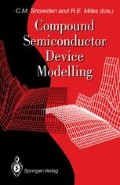Abstract
This chapter describes how laser diodes for optical communication, with their complex structure and physical interactions can be simulated. These lasers are usually of such a nature that variations in the lateral and transverse direction, as well as the electronic transport problem can be treated in a most simplified way, while longitudinal and spectral variations need to be taken into account in a detailed way.
Access this chapter
Tax calculation will be finalised at checkout
Purchases are for personal use only
Preview
Unable to display preview. Download preview PDF.
References
K. Petermann, “Laser Diode Modulation and Noise”, KTK Publishers, Tokyo, 1988.
G. Agrawal, N. Dutta, “Long-wavelength semiconductor lasers”, Van Nostrand Reinhold, New York, 1986.
M. Amann, “New stripe-geometry laser with simplified fabrication process”, El. Lett., Vol. 15, pp.441–442, July, 1979.
K. Saito, R. Ito, “Buried-heterostructure AlGaAs lasers”, IEEE Journ. Quant. El., Vol. 16, pp. 205–215, February, 1980.
D. Cook, F. Nash, “Gain-induced guiding and astigmatic output beam of GaAs lasers”, Journ. Appl. Phys., Vol. 46, p. 1660, 1975.
H. Casey, M. Panish, “Heterostructure Lasers, part A: Fundamental Principles”, Academic Press, New York, 1978.
M. Asada, Y. Suematsu, “Density-matrix theory of semiconductor lasers with relaxation broadening model: gain and gain-suppression in semiconductor lasers”, IEEE Journ. Quant. EL, Vol. 21, pp. 434–442, May, 1985.
A. Yariv, “Quantum Electronics”, 2nd Ed., Wiley, New York, 1980.
D. Marcuse, “Principles of Quantum Electronics”, Academic Press, New York, 1980.
P. Vankwikelberge, “Theoretische studie van statische en dynamische longitudinale effecten in Fabry-Perot en DFB-diodelasers”, Ph. D. thesis (in Dutch), university of Gent, 1990.
G. Thompson, “Physics of semiconductor laser devices”, Wiley, New York, 1980.
M Lax, “Classical Noise IV: Langevin Methods”, Rev. Mod. Phys., Vol. 38, pp. 541–566, July, 1966.
C. Henry, “Theory of Spontaneous Emission Noise in Open Resonators and its Application to Lasers and Optical Amplifiers”, Journ. Lightw. Techn., Vol. 4, pp. 288–297, March, 1986.
J. D. Jackson, “Classical Electrodynamics”, Wiley, New York, 1962.
P. Vankwikelberge, G. Morthier, R. Baets, “CLADISS, a longitudinal, multi mode model for the analysis of the static, dynamic and stochastic behaviour of diode lasers with distributed feedback”, IEEE Journ. Quant. EL, October 1990.
P. Vankwikelberge, G. Morthier, K. David, R. Baets, “CLADISS, a new diode laser simulator”, Technical Digest Topical Meeting on Integrated Photonics Research, Hilton Head, March, 1990.
J. Buus, “Mode selectivity in DFB lasers with cleaved facets”, Electron. Lett., Vol. 21, pp. 179–180, 1985.
P. Mols, P. Kuindersma, W. Van Es, I. Baele, “Yield and device charac-teristics of DFB lasers: statistics and novel coating design in theory and experiment”, IEEE Journ. Quant. EL, Vol.25, June, 1989.
G. Morthier, F. Libbrecht, K. David, P. Vankwikelberge, R. Baets, “Theoretical investigation of the 2nd order harmonic distortion in the AM-response of 1.55 µm F-P and DFB lasers”, IEEE Journ. Quant. EL, Vol. 27, pp. 1990–2002, August, 1991.
K. Lau, A. Yariv, “Intermodulation distortion in semiconductor injection lasers”, Appl. Phys. Lett., Vol. 45, pp. 1034–1036, 1984.
’Subroutine COLROW, Algorithm 603, ACM-Trans. Math. Software, Vol. 9, pp. 376–380, September, 1983.
K. Vahala, A. Yariv, “Semiclassical Theory of Noise in Semiconductor Lasers - Part I”, IEEE Journ. Quant. EL, Vol. 19, pp. 1096–1101, June, 1983.
Author information
Authors and Affiliations
Editor information
Editors and Affiliations
Rights and permissions
Copyright information
© 1993 Springer-Verlag London Limited
About this chapter
Cite this chapter
Morthier, G.J.I., Baets, R.G. (1993). Modelling of Distributed Feedback Lasers. In: Snowden, C.M., Miles, R.E. (eds) Compound Semiconductor Device Modelling. Springer, London. https://doi.org/10.1007/978-1-4471-2048-3_7
Download citation
DOI: https://doi.org/10.1007/978-1-4471-2048-3_7
Publisher Name: Springer, London
Print ISBN: 978-1-4471-2050-6
Online ISBN: 978-1-4471-2048-3
eBook Packages: Springer Book Archive

